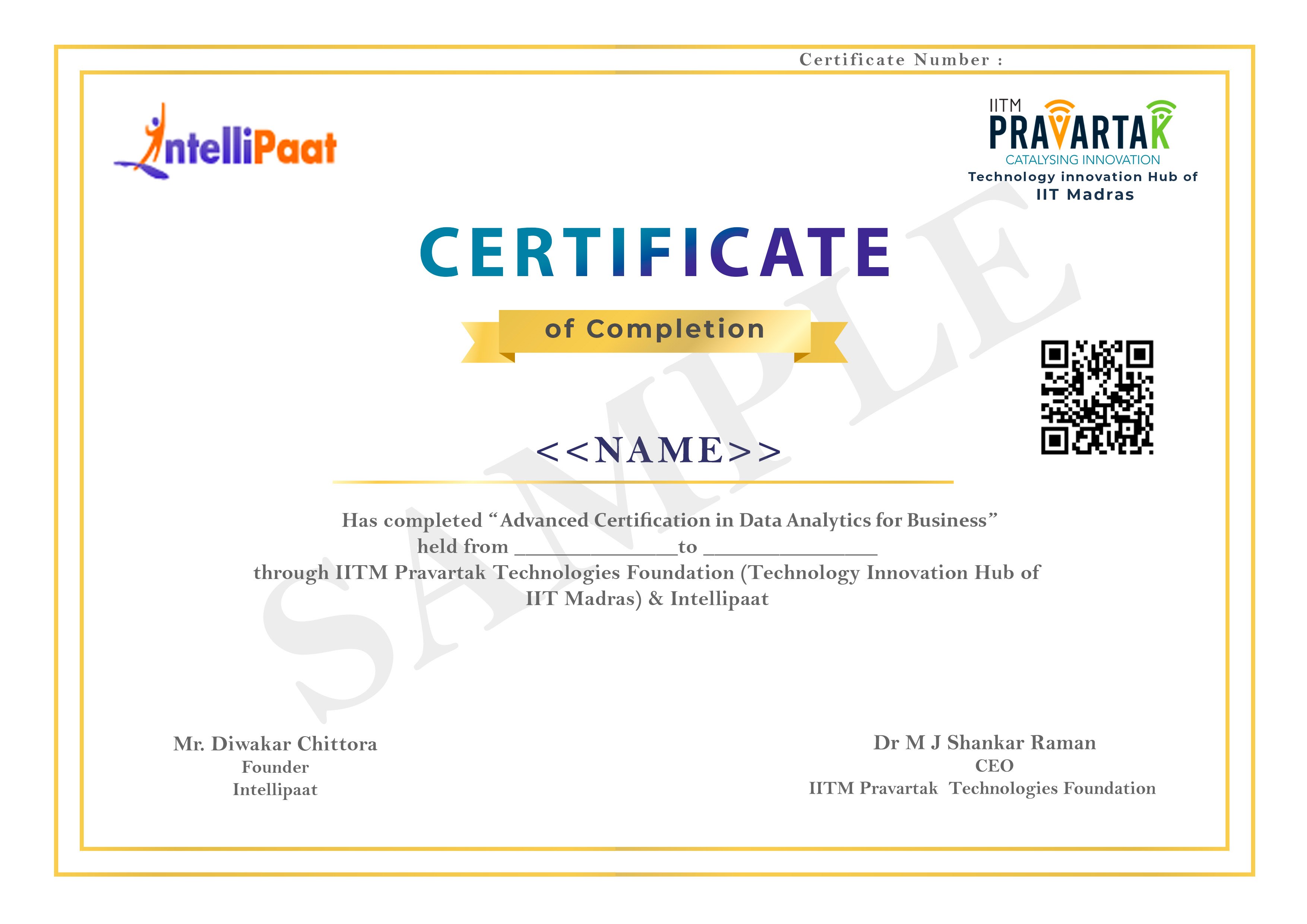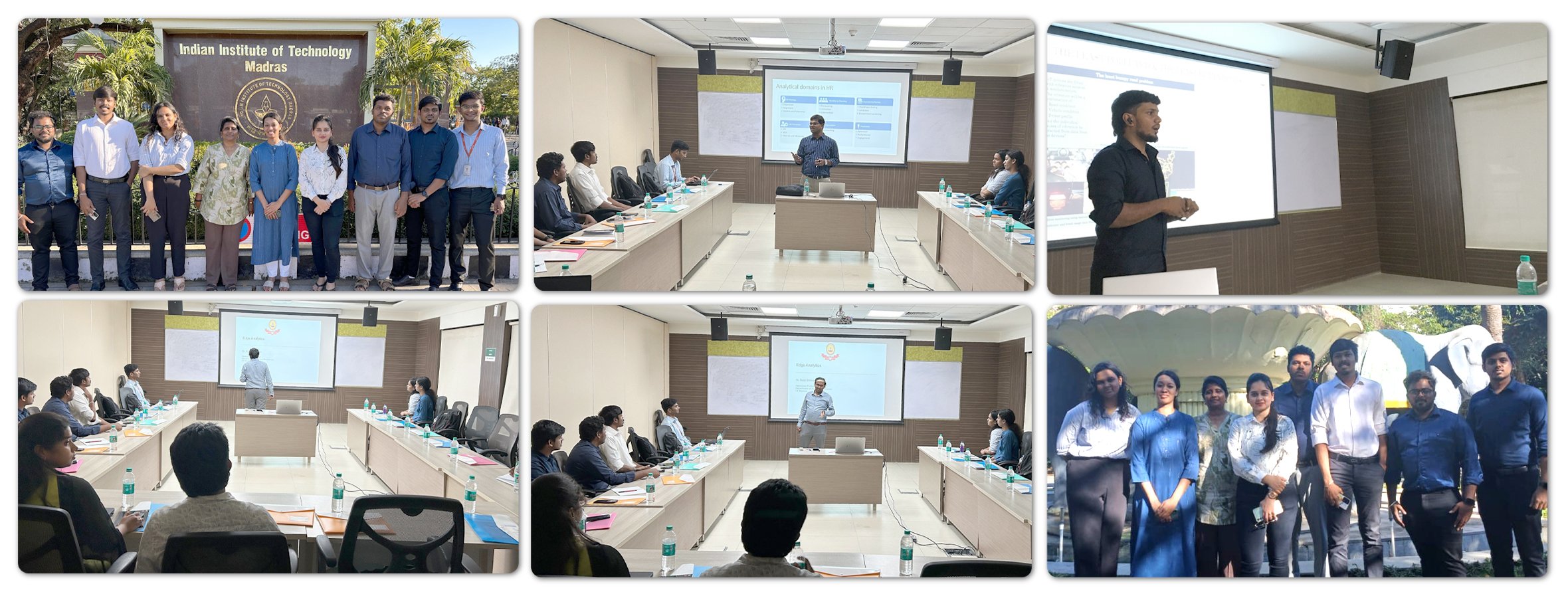Your cart is currently empty.
Jumpstart your career with IITM Pravartak (A Technology Innovation Hub of IIT Madras) & Intellipaat’s advanced certification in Data Science & Business Analytics course. Master the domain with multiple business case studies and industry-relevant projects under the guidance of the esteemed IIT Madras faculty.

Watch
Course PreviewLearning Format
Online Bootcamp
Live Classes
7 Months
Campus Immersion
at IITM Pravartak
IITM Pravartak
Certification
EMI Starts
at ₹5500/month*
The program led by the IIT Madras faculty aims at helping learners develop a strong skillset including descriptive statistics, probability distributions, predictive modeling, time series forecasting, data architecture strategies, business analytics, and other skills to excel in this field.
About IITM Pravartak Digital Skills Academy
IITM Pravartak, a Technology Innovation Hub of IIRM is funded by the Department of Science and Technology, GoI under its National Mission on Interdisciplinary Cyber-Physical Systems (NM-ICPS), focuses on application-oriented research and innovation in the areas SNACS. BharOS, India’s first mobile operating system is developed by an IITM Pravartak incubated company.
Key Achievements of IIT Madras:
Use data analysis and data processing to understand business challenges and offer the best solutions to the organization.
Extract data from the respective sources to perform business analysis, and generate reports, dashboards, and metrics to monitor the company’s performance.
Create blueprints for managing data to facilitate easy integration, centralization, and protection of the database along with due security precautions.
Build a cross-brand and robust strategy of data acquisition and analytics, along with designing raw data transformation for analytical application.
Design and build machine learning models to derive intelligence for the numerous services and products offered by the organization.
With the help of several Machine Learning tools and technologies, build statistical models with huge chunks of business data.
Skills to Master
SQL
Data Wrangling
Data Analysis
Prediction algorithms
Data visualization
Time Series
Machine Learning
Power BI
Advanced Statistics
Data Mining
R Programming
Tools to Master
Case Study
Writing comparison data between the past year and to present year concerning top products, ignoring the redundant/junk data, identifying the meaningful data, and identifying the demand in the future(using complex subqueries, functions, pattern matching concepts).
Introduction to Python and IDEs – The basics of the Python programming language, and how you can use various IDEs for Python development like Jupyter, Pycharm, etc.
Python Basics – Variables, Data Types, Loops, Conditional Statements, functions, decorators, lambda functions, etc.
Object Oriented Programming – Introduction to OOPs concepts like classes, objects, inheritance, abstraction, polymorphism, encapsulation, etc.
Data Manipulation with Numpy, Pandas, and Visualization – Using large datasets, you will learn about various techniques and processes that will convert raw unstructured data into actionable insights for further computations i.e. machine learning models, etc.
Case Study – The culmination of all the above concepts with real-world problem statements for better understanding.
Descriptive Statistics
Probability
Inferential Statistics
Case Study
This case study will cover the following concepts:
Introduction to Machine Learning
Regression
Classification
Clustering
Supervised Learning
Unsupervised Learning
Performance Metrics
Time Series Forecasting – Making use of time series data, gathering insights and useful forecasting solutions using time series forecasting
Business Domains – Learn about various business domains and understand how one differs from the other.
Understanding the business problems and formulating hypotheses – Learn about formulating hypotheses for various business problems on samples and populations.
Exploratory Data Analysis to Gather Insights – Learn about exploratory data analysis and how it enables a foolproof producer of actionable insights.
Data Storytelling: Narrate stories in a memorable way – Learn to narrate business problems and solutions in a simple relatable format that makes it easier to understand and recall.
Case Study
This case study will cover the following concepts:
Introduction to KNIME – Learn about the KNIME tool that can be quite efficient for data analytics, creating workflows, etc.
Working with data in KNIME – Learn about creating workflows, loading datasets in KNIME, etc.
Loops in KNIME – Learn about the loops in KNIME that enable efficient data transformation in KNIME
Feature Selection, Hyperparameter optimization in KNIME – Learn about hyperparameter optimization, and feature selection in KNIME that will enable efficient machine learning models.
Case Study:
This case study will cover the following concepts:
Feature Selection – Feature selection techniques in Python that include recursive feature elimination, Recursive feature elimination using cross-validation, variance threshold, etc.
Feature Engineering – Feature engineering techniques that help in reducing the best features to use for data modeling.
Model Tuning – Optimization techniques like hyperparameter tuning to increases the efficiency of the machine learning models.
Introduction to Spark – Introduction to Spark, Spark overcomes the drawbacks of working on MapReduce, Understanding in-memory MapReduce, Interactive operations on MapReduce, Spark stack, fine vs. coarse-grained update, Spark Hadoop YARN, HDFS Revision, and YARN Revision, The overview of Spark and how it is better than Hadoop, Deploying Spark without Hadoop, Spark history server and Cloudera distribution
Spark Basics – Spark installation guide, Spark configuration, Memory management, Executor memory vs. driver memory, Working with Spark Shell, The concept of resilient distributed datasets (RDD), Learning to do functional programming in Spark, and architecture of Spark.
Spark SQL and Data Frames
1. Learning about Spark SQL
2. The context of SQL in Spark for providing structured data processing
3. JSON support in Spark SQL
4. Working with XML data
5. Parquet files
6. Creating Hive context
7. Writing data frame to Hive
8. Reading JDBC files
9. Understanding the data frames in Spark
10. Creating Data Frames
11. Manual inferring of schema
12. Working with CSV files
13. Reading JDBC tables
14. Data frame to JDBC
15. User-defined functions in Spark SQL
16. Shared variables and accumulators
17. Learning to query and transform data in data frames
18. Data frame provides the benefit of both Spark RDD and Spark SQL
19. Deploying Hive on Spark as the execution engine
Problem Statement and Project Objectives – You will learn how to formulate various problem statements and understand the business objective of any problem statement that comes as a requirement.
Approach for the Solution – Creating various statistical insights-based solutions to approach the problem will guide your learnings to finish a project from scratch.
Optimum Solutions – Formulating actionable insights backed by statistical evidence will help you find the most effective solution for your problem statements.
Evaluation Metrics – You will be able to apply various evaluation metrics to your project/solution. It will validate your approach and point towards shortcomings backed by insights, if any.
Gathering Actionable insights – You will learn about how a problem’s solution isn’t just creating a machine learning model, the insights that were gained from your analysis should be presentable in the form of actionable insights to capitalize on the solutions formulated for the problem statement.
Customer Churn – The case study involves studying the customer data for a given XYZ company, and using statistical tests and predictive modeling, we will gather insights to efficiently create an action plan for the same.
Sales Forecasting – By studying the various patterns and sales data for a firm/store, we will use the time series forecasting method to forecast the number of sales for the next time period(weeks, months, years, etc.)
Census – After studying the population data, we will gather insights and through predictive modeling try to create actionable insights on the same, it could be the average income of an individual, or most likely profession, etc.
Predictive Modeling – Various case studies on categorical and continuous data, to create predictive models that will predict specific outcomes based on the business problems.
HR Analytics – Based on the data provided by a firm, we will study the HR analytics data, and create actionable insights using various statistical tests and hypothesis testing.
Dimensionality Reduction – To understand the impact of multidimensional data, we will go through various dimensionality reduction techniques and optimize the computational time on the same that will eventually be used for various classification and regression problems.
Housing – A case study that will give you insight into how real estate firms can narrow down on pricing, customer choices, etc. using various predictive modeling techniques.
Customer Segmentation – Using unsupervised learning techniques, we will learn about customer segmentation, which can be quite useful for e-commerce sectors, stores, marketing funnels, etc.
Inventory Management – In this case study, you will learn about how meaningful insights can be used to drive a supply chain, using predictive modeling and clustering techniques.
Disease Prediction – A medical endeavor that is achieved through machine learning will give you an insight into how the predictive model can prove to be a great marvel in the early detection of various diseases.
Excel Fundamentals
Excel For Data Analytics
Data Visualization with Excel
Ensuring Data and File Security
Getting Started with Macros
Statistics with Excel
Introduction to Data Warehouse – Introducing Data Warehouse and Business Intelligence, understanding the difference between database and data warehouse, working with ETL tools, and SQL parsing.
Architecture of Data Warehouse – Understanding the Data Warehousing Architecture, system used for Reporting and Business Intelligence, understanding OLAP vs. OLTP, and introduction to Cubes.
Data Modeling Concepts – The various stages from Conceptual Model, Logical Model to Physical Schema, Understanding the Cubes, benefits of Cube, working with OLAP multidimensional Cube, creating Report using a Cube.
Data Normalization – Understanding the process of Data Normalization, rules of normalization for first, second, and third normal, BCNF, deploying Erwin for generating SQL scripts.
Dimension and Fact Table – The main components of Business Intelligence – Dimensions and Fact Tables, understanding the difference between Fact Tables & Dimensions, and understanding Slowly Changing Dimensions in Data Warehousing.
Cubes, and OLAP – Compilation and optimization, understanding types and scope of cubes, Data Warehousing Vs. Cubes, limitations of Cubes and evolution of in-memory analytics.
Power BI Basics
DAX
Data Visualization with Analytics
Case Study:
This case study will cover the following concepts:

Admission Details
The application process consists of three simple steps. An offer of admission will be made to selected candidates based on the feedback from the interview panel. The selected candidates will be notified over email and phone, and they can block their seats through the payment of the admission fee.
Submit Application
Tell us a bit about yourself and why you want to join this program
Application Review
An admission panel will shortlist candidates based on their application
Admission
Selected candidates will be notified within 1–2 weeks
Total Admission Fee
EMI Starts at
We partnered with financing companies to provide very competitive finance options at 0% interest rate
Financing Partners
![]()
Admissions close once the required number of students is enrolled for the upcoming cohort. Apply early to secure your seat.
| Date | Time | Batch Type | |
|---|---|---|---|
| Program Induction | 28th Sep 2025 | 08:00 PM IST | Weekend (Sat-Sun) |
Intellipaat provides career services for all the learners enrolled in this course. IITM Pravartak is not responsible for career services. Intellipaat career services for this program contains resume building and review of linkedin profile.
Upon completion of the Data Science and Business Analytics training and execution of the various projects in this program, you will receive a joint Advanced Certification in Data Science and Business Analytics from Intellipaat and IITM Pravartak.
The certification in Data Science and Business Analytics is conducted by leading experts from IITM Pravartak and Intellipaat who will assist you in kick-starting your career in these domains through their vast industry-relevant experience.
Also, the course curriculum along with videos, live sessions, and assignments will help you gain in-depth knowledge in Data Science and Business Analytics, apart from providing hands-on experience in these domains through real-time projects.
If you fail to attend any of the live lectures, you will get a copy of the recorded session in the next 12 hours. Moreover, if you have any other queries, you can get in touch with our course advisors or post them on our community platform.
To register for the program, you can reach out to our learning consultants or contact us through the above-given details on this page.
There will be a two-day campus immersion module at IITM Pravartak during which learners will visit the campus. You will learn from the faculty as well as interact with your peers. However, this is subject to the COVID-19 situation and guidelines provided by the Institute. The cost of travel and accommodation will be borne by the learners. However, the campus immersion module is optional.
Please note that the course fees is non-refundable and we will be at every step with you for your upskilling and professional growth needs.
Due to any reason you want to defer the batch or restart the classes in a new batch then you need to send the batch defer request on [email protected] and only 1 time batch defer request is allowed without any additional cost.
Learner can request for batch deferral to any of the cohorts starting in the next 3-6 months from the start date of the initial batch in which the student was originally enrolled for. Batch deferral requests are accepted only once but you should not have completed more than 20% of the program. If you want to defer the batch 2nd time then you need to pay batch defer fees which is equal to 10% of the total course fees paid for the program + Taxes.
After completing this training program, you will have the necessary skills to solve complex business problems using machine learning algorithms and derive valuable insights from raw data. The program includes hands-on assignments, multiple case studies, and real-time project work, which will help you master the skills required to excel as a data analyst.
Yes, Intellipaat certification is highly recognized in the industry. Our alumni work in more than 10,000 corporations and startups, which is a testament that our programs are industry-aligned and well-recognized. Additionally, the Intellipaat program is in partnership with the National Skill Development Corporation (NSDC), which further validates its credibility. Learners will get an NSDC certificate along with Intellipaat certificate for the programs they enroll in.
What is included in this course?
 Click to Zoom
Click to Zoom










